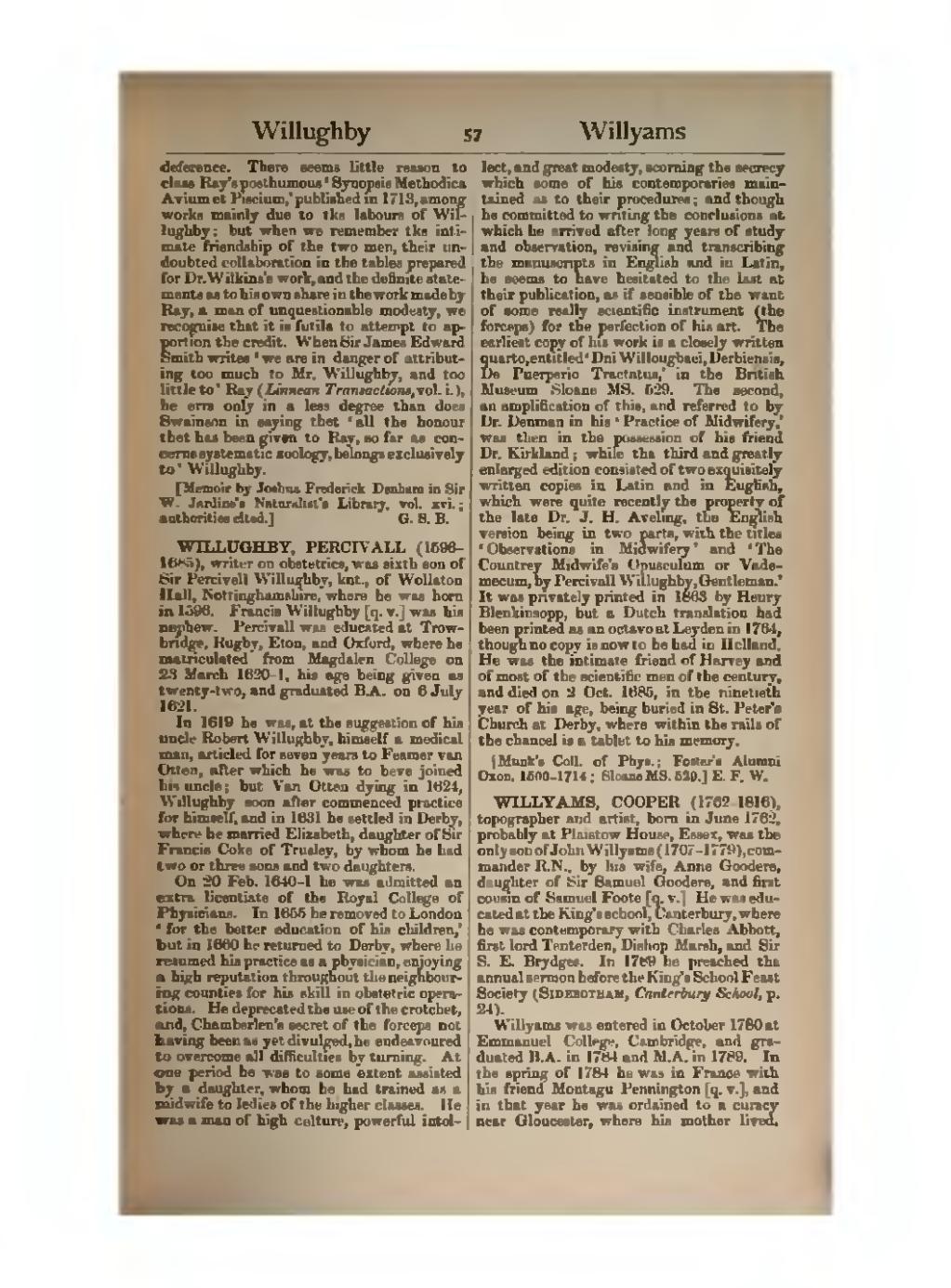deference. There seems little reason to class Ray's posthumous ‘Synopsis Methodica Avium et Piscium,’ published in 1713, among works mainly due to the labours of Willughby; but when we remember the intimate friendship of the two men, their undoubted collaboration in the tables prepared for Dr. Wilkins's work, and the definite statements as to his own share in the work made by Ray, a man of unquestionable modesty, we recognise that it is futile to attempt to apportion the credit. When Sir James Edward Smith writes ‘we are in danger of attributing too much to Mr. Willughby, and too little to’ Ray (Linnean Transactions, vol. i.), he errs only in a less degree than does Swainson in saying that ‘all the honour that has been given to Ray, so far as concerns systematic zoology, belongs exclusively to’ Willughby.
[Memoir by Joshua Frederick Denham in Sir W. Jardine's Naturalist's Library, vol. xvi.; authorities cited.]
WILLUGHBY, PERCIVALL (1596–1685), writer on obstetrics, was sixth son of Sir Percivall Willughby, knt., of Wollaton Hall, Nottinghamshire, where he was born in 1596. Francis Willughby [q. v.] was his nephew. Percivall was educated at Trowbridge, Rugby, Eton, and Oxford, where he matriculated from Magdalen College on 23 March 1620–1, his age being given as twenty-two, and graduated B.A. on 6 July 1621.
In 1619 he was, at the suggestion of his uncle Robert Willughby, himself a medical man, articled for seven years to Feamer van Otten, after which he was to have joined his uncle; but Van Otten dying in 1624, Willughby soon after commenced practice for himself, and in 1631 he settled in Derby, where he married Elizabeth, daughter of Sir Francis Coke of Trusley, by whom he had two or three sons and two daughters.
On 20 Feb. 1640–1 he was admitted an extra licentiate of the Royal College of Physicians. In 1655 he removed to London ‘for the better education of his children,’ but in 1660 he returned to Derby, where he resumed his practice as a physician, enjoying a high reputation throughout the neighbouring counties for his skill in obstetric operations. He deprecated the use of the crotchet, and, Chamberlen's secret of the forceps not having been as yet divulged, he endeavoured to overcome all difficulties by turning. At one period he was to some extent assisted by a daughter, whom he had trained as a midwife to ladies of the higher classes. He was a man of high culture, powerful intellect, and great modesty, scorning the secrecy which some of his contemporaries maintained as to their procedures; and though he committed to writing the conclusions at which he arrived after long years of study and observation, revising and transcribing the manuscripts in English and in Latin, he seems to have hesitated to the last at their publication, as if sensible of the want of some really scientific instrument (the forceps) for the perfection of his art. The earliest copy of his work is a closely written quarto, entitled ‘Dni Willougbaei, Derbiensis, De Puerperio Tractatus,’ in the British Museum Sloane MS. 529. The second, an amplification of this, and referred to by Dr. Denman in his ‘Practice of Midwifery,’ was then in the possession of his friend Dr. Kirkland; while the third and greatly enlarged edition consisted of two exquisitely written copies in Latin and in English, which were quite recently the property of the late Dr. J. H. Aveling, the English version being in two parts, with the titles ‘Observations in Midwifery’ and ‘The Countrey Midwife's Opusculum or Vade-mecum, by Percivall Willughby, Gentleman.’ It was privately printed in 1863 by Henry Blenkinsopp, but a Dutch translation had been printed as an octavo at Leyden in 1764, though no copy is now to be had in Holland. He was the intimate friend of Harvey and of most of the scientific men of the century, and died on 2 Oct. 1685, in the ninetieth year of his age, being buried in St. Peter's Church at Derby, where within the rails of the chancel is a tablet to his memory.
[Munk's Coll. of Phys.; Foster's Alumni Oxon. 1500–1714; Sloane MS. 529.]
WILLYAMS, COOPER (1762–1816), topographer and artist, born in June 1762, probably at Plaistow House, Essex, was the only son of John Willyams (1707–1779), commander R.N., by his wife, Anne Goodere, daughter of Sir Samuel Goodere, and first cousin of Samuel Foote [q. v.] He was educated at the King's school, Canterbury, where he was contemporary with Charles Abbott, first lord Tenterden, Bishop Marsh, and Sir S. E. Brydges. In 1789 he preached the annual sermon before the King's School Feast Society (Sidebotham, Canterbury School, p. 24).
Willyams was entered in October 1780 at Emmanuel College, Cambridge, and graduated B.A. in 1784 and M.A. in 1789. In the spring of 1784 he was in France with his friend Montagu Pennington [q. v.], and in that year he was ordained to a curacy near Gloucester, where his mother lived.
